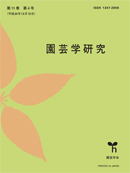Volume 11, Issue 4
Displaying 1-20 of 20 articles from this issue
- |<
- <
- 1
- >
- >|
REVIEW
-
2012 Volume 11 Issue 4 Pages 433-438
Published: 2012
Released on J-STAGE: December 28, 2012
Download PDF (1357K)
REPORTS
Breeding & Germplasm Resources
-
2012 Volume 11 Issue 4 Pages 439-447
Published: 2012
Released on J-STAGE: December 28, 2012
Download PDF (551K) -
2012 Volume 11 Issue 4 Pages 449-457
Published: 2012
Released on J-STAGE: December 28, 2012
Download PDF (1292K)
Propagation & Transplant Production
-
2012 Volume 11 Issue 4 Pages 459-465
Published: 2012
Released on J-STAGE: December 28, 2012
Download PDF (615K)
Crop Production & Cropping Type
-
2012 Volume 11 Issue 4 Pages 467-475
Published: 2012
Released on J-STAGE: December 28, 2012
Download PDF (554K) -
2012 Volume 11 Issue 4 Pages 477-483
Published: 2012
Released on J-STAGE: December 28, 2012
Download PDF (941K) -
2012 Volume 11 Issue 4 Pages 485-489
Published: 2012
Released on J-STAGE: December 28, 2012
Download PDF (1033K) -
2012 Volume 11 Issue 4 Pages 491-495
Published: 2012
Released on J-STAGE: December 28, 2012
Download PDF (418K) -
2012 Volume 11 Issue 4 Pages 497-503
Published: 2012
Released on J-STAGE: December 28, 2012
Download PDF (1692K) -
2012 Volume 11 Issue 4 Pages 505-513
Published: 2012
Released on J-STAGE: December 28, 2012
Download PDF (1298K) -
2012 Volume 11 Issue 4 Pages 515-521
Published: 2012
Released on J-STAGE: December 28, 2012
Download PDF (808K) -
2012 Volume 11 Issue 4 Pages 523-529
Published: 2012
Released on J-STAGE: December 28, 2012
Download PDF (601K) -
2012 Volume 11 Issue 4 Pages 531-536
Published: 2012
Released on J-STAGE: December 28, 2012
Download PDF (649K) -
2012 Volume 11 Issue 4 Pages 537-543
Published: 2012
Released on J-STAGE: December 28, 2012
Download PDF (753K) -
2012 Volume 11 Issue 4 Pages 545-551
Published: 2012
Released on J-STAGE: December 28, 2012
Download PDF (1404K)
Growth Regulation
-
2012 Volume 11 Issue 4 Pages 553-559
Published: 2012
Released on J-STAGE: December 28, 2012
Download PDF (1402K) -
2012 Volume 11 Issue 4 Pages 561-567
Published: 2012
Released on J-STAGE: December 28, 2012
Download PDF (2926K) -
2012 Volume 11 Issue 4 Pages 569-575
Published: 2012
Released on J-STAGE: December 28, 2012
Download PDF (1508K)
Postharvest Physiology & Technology
-
2012 Volume 11 Issue 4 Pages 577-583
Published: 2012
Released on J-STAGE: December 28, 2012
Download PDF (802K)
Erratum
-
2012 Volume 11 Issue 4 Pages 584
Published: 2012
Released on J-STAGE: December 28, 2012
Download PDF (42K)
- |<
- <
- 1
- >
- >|
